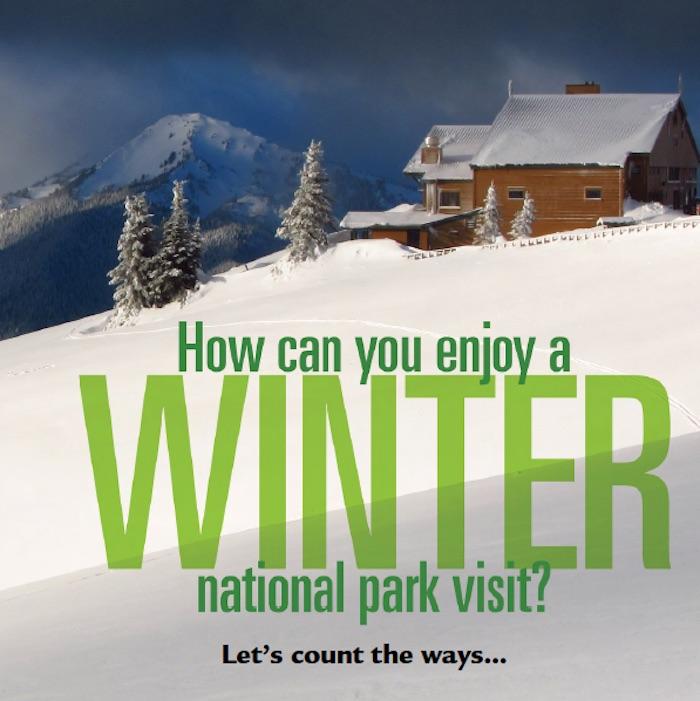 Winter could leave Hurricane Ridge at Olympic National Park buried in a very, very deep blanket of fluff/NPS, Dave Turner
Winter could leave Hurricane Ridge at Olympic National Park buried in a very, very deep blanket of fluff/NPS, Dave Turner1. Head to Death Valley National Park in Nevada and California for one of the more mild winter experiences in the park system. While the park might get snow atop Telescope Peak, which reaches 11,049 feet, down in the sand dunes the daily highs for December- February are typically in the 60s and 70s, perfect for exploring the park.
2. Schedule a trip to Everglades National Park in Florida. Winters are milder, and less buggy, than the mid-summer months, and wildlife usually easier to spot. If there’s a downside, it’s all the other folks who agree with this strategy. You could leave the crowds behind by paddling off into Florida Bay by sea kayak or canoe. Spend the nights on platforms known as chickees that are elevated above the water.
3. Another warm-weather winter destination is Virgin Islands National Park on the island of St. John, where the breezes are mild, the currents warm, and the beaches white as snow…without the cold.
4. You can stay within the snowbelt, yet avoid the snow (for a while) by going underground at Mammoth Cave National Park, where the subterranean temperature usually stays around 54 degrees year-round. Sign up for the Domes and Dripstones Tour and you’ll see Frozen Niagara.
5. Keep an eye on the weather and hope for an Arctic Express cold front that will turn the shoreline caves at Apostle Islands National Lakeshore in Wisconsin into “Ice Caves” and take a trip to explore them.
6. Walk among the trees—the really, really, big trees—at Sequoia National Park’s Giant Forest in the snow. Cross-country skis and snowshoes are optional, depending on the snow depth. If you like to ski, test yourself on the Trail of the Sequoias, an advanced intermediate route, or the Pear Lake Trail, recommended for advanced skiers. This 12-mile round-trip takes you to the 9,500-foot summit of “the Hump.”
7. Trek to Yellowstone National Park in Wyoming and marvel at the steam billowing from Old Faithful when the mercury dips to 20 degrees Fahrenheit below zero or more. Then head inside the Snow Lodge for a nice hot drink. Stop at the visitor center to pick up maps of cross-country and snowshoe trails. A great morning or afternoon trek leads from Old Faithful down to Lone Star Geyser. Just be sure to check with the rangers for the predicted time of eruption so you arrive before, not after, it goes off.
8. Cross your fingers that New England gets dumped on again as it did last winter and head to Acadia National Park along Maine’s coastline to explore the landscape on snowshoes or cross-country skis. With the exception of the park’s carriage roads, the use of dog sleds, dog carts, and skijoring with dogs is permitted on all closed motor roads and fire roads.
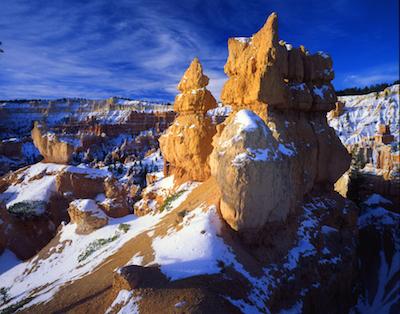
Explore the snowy hoodoos of Bryce Canyon National Park this winter/NPS
9. Set your sights on a February visit to Bryce Canyon National Park in Utah to attend the annual winter festival there. Or visit during any winter month to enjoy the incredible contrast of white snow against red-rock hoodoos. Time your visit to the full moon and join a rangerguided nighttime snowshoe hike from November through March when snow depth exceeds 12 inches. Snowshoes and poles are provided but you must provide your own snow-boots or waterproof hiking boots.
10. Do you like waiting around a hole in the ice for the fish to bite? Voyageurs National Park in Minnesota is popular with ice anglers. Or, the Rainy Lake Visitor Center is open year-round and offers crosscountry ski rentals and a snowshoe loan program during the winter.
11. Sleeping Bear Dunes National Lakeshore in Michigan is another great spot for cross-country skiing when the snow gods are willing. Guided snowshoe hikes with a ranger are offered on Saturdays and during the winter holidays. Bring your own snowshoes or try out those available for use on the hikes.
12. Head to southern Arizona and Saguaro National Park, where the lower elevations of the park typically are snow-free and warm with daily highs in the mid-60s, a hiker’s delight. Or, test your winter camping skills by heading up into the Rincon Mountains, which top out around 8,500 feet. Just be sure to pack plenty of warm clothing, for it does occasionally snow at this level of the park.
13. Glacier National Park in Montana might not be entirely accessible in winter, as the Going-to-the-Sun Road closes to wheeled traffic, but there is still much to do. Try a 16-mile round-trip cross-country ski from Lake McDonald Lodge to Avalanche Lake, or strap on a pair of snowshoes and explore any of the forests accessible via the roads. Check for when rangers lead snowshoe hikes.
14. Check with the staff at Cuyahoga Valley National Park in Ohio to find out when the Polar Express™ runs. Typically a park partner runs the train in November and December. Children are encouraged to ride in their pajamas and enjoy a reading of The Polar Express™ during a journey to the North Pole. Cookies and hot chocolate are served. The park also averages five feet of snow, and when it falls and piles up, snowshoeing and cross-country skiing are popular here. The Winter Sports Center at Kendall Lake Shelter is the starting point for both activities.
15. Explore the western side of Rocky Mountain National Park, where the heaviest winter snows fall before storms cross the Continental Divide, by snowshoe or cross-country ski. On the eastern side, head to Bear Lake for snowshoeing on the trails surrounding the lake, or check with the rangers for snow-free trails for great hiking.
16. Snowshoe novices, and experts, are welcome at Grand Teton National Park in Wyoming, where rangers typically lead snowshoe tours every Saturday in winter. The Teton Park Road is closed to wheeled traffic and open to crosscountry skiers and snowshoers. The road gets intermittently groomed for cross-country and skate skiing from the Taggart Lake parking area to Signal Mountain.
17. Plan to be in Alaska in February 26-28 to help celebrate Denali National Park’s 16th annual Winterfest, a park-community celebration that has guided snowshoe walks, winter camping demos, films, and more.
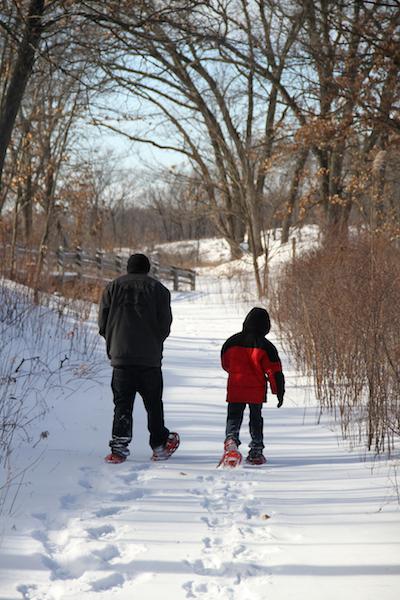
Miller Woods is a popular snowshoeing area at Indiana Dunes National Lakeshore/NPS
18. At Indiana Dunes National Lakeshore in Indiana, the best option for cross-country skiing is the Glenwood Dunes Trail. This 6.4-mile trail is a series of interconnecting loops that meander through gently rolling wooded dunes.
19. Winter wasn’t kind to Mount Rainier National Park in Washington last year, so hope that it bounces back to normal and allows the snow play area at Paradise to open for snow sports. This area generally opens in late December and stays open through mid-March, depending on snow. Sliding and tobogganing are permitted only in the designated snow play area at Paradise. The park offers ranger-guided snowshoe walks there.
20. Pictured Rocks National Lakeshore in Michigan generally sees 140 inches of snow every winter, which makes the park popular for cross-country skiing, snowmobiling, ice climbing, winter camping, ice fishing, and snowshoeing.
21. Mix volcanics with crosscountry skiing at Craters of the Moon National Monument and Preserve in southern Idaho. Here the dark ‘lavascape’ is set off by dustings of snow. When enough snow accumulates, the park’s Loop Drive is open to cross-country skiers and snowshoers. The groomed track is 4-7 miles in length with mostly level terrain or gentle hills. You also can follow the orange snow poles to explore a 1.5-mile Snowshoe Loop Trail or venture off of the winter trails and climb a cinder cone. Snowshoe walks typically are scheduled in January and February.
22. With the strong El Niño that formed in the Pacific promising a snowy winter for the Colorado Rockies, consider a visit to Mesa Verde National Park. Here you’ll find opportunities for cross-country skiing and snowshoeing. Once there’s enough snow, crews groom the trails for both activities.
23. Olympic National Park in Washington has opportunities for alpine skiing, cross-country skiing, and snowshoeing on Hurricane Ridge. Before you go, though, check both the park’s website and hurricaneridge.com to see if the ridge is open for winter activities.
24. Test your winter backpacking skills at Great Smoky Mountains National Park in North Carolina/ Tennessee, where the mountains can collect deep snows, deep enough for skiing and snowshoeing. Just be sure you have the right gear…and leave word with family and friends where you plan to go in the park.
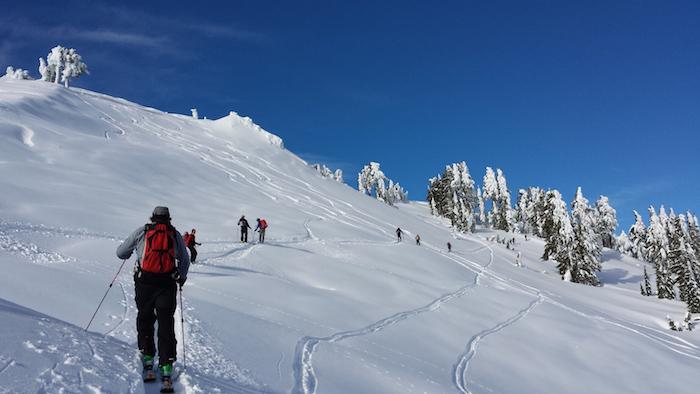
Lassen Volcanic National Park's snowy slopes entice backcountry skiers/NPS
25. Keep your eyes on the volcano as you snowshoe, or ski, around Lassen Peak at Lassen Volcanic National Park in California. Backcountry skiers have boundless slopes to weave their skis through. Winter camping also is a growing activity in the park.
26. Hawai’i Volcanoes National Park is always a tempting option, winter or summer. If the winter weather cooperates, you could follow a day on the beach with one frolicking in the snow on Mauna Loa! If snow is not in the forecast, pick up a backcountry permit and hike to the summit cabin at 13,250 feet and spend the night.
27. Summer can be a miserable time to backpack Big Bend National Park in Texas due to the hot weather. Winter, though, is another story. Those looking to test their abilities should consider the Outer Mountain Loop, a 30-mile circuit that links the Pinnacles, Juniper Canyon, Dodson, Blue Creek, and Laguna Meadows trails as it wends through woodlands and desert.
28. Like Big Bend, Joshua Tree National Park in California can be deathly hot in summer, which is why it’s such a great winter destination. Climbers view the park with the twisted trees as a Mecca for its many bouldering routes. Within the park rise more than 8,000 climbing routes and bouldering problems.
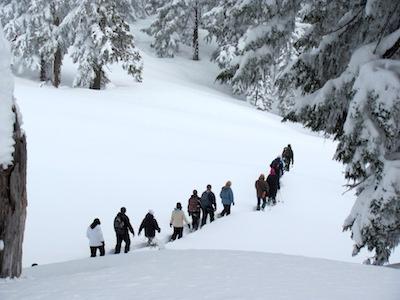
Have you snowshoed at Crater Lake National Park?/NPS
29. Cold, snowy winters might not allow you to glimpse the blue waters of Crater Lake National Park in Oregon, but they will provide endless miles of snowshoeing and cross-country skiing possibilities, as well as challenges for winter camping. You can drive to Rim Village and start your trek from there. Be careful, though, as avalanches have slid here and snow cornices have broken off and plunged some to their deaths.
30. Shenandoah National Park doesn’t get the love it deserves in winter…which can be a plus if you like solitude. Low snow years are perfect for backpacking the Appalachian Trail through the park. Deep snow years are great for snowshoeing some of the shorter trails. A demanding snowshoe trek, depending on snow depth and your fitness, is the 6.5-mile loop that takes you down to Dark Hollow Falls and around Big Meadows. Of course, you could always reduce that mileage by either hiking around the meadows or doing an out-and-back to the falls.
31. Like other parks, the Grand Canyon doesn’t close, and winter can be a great time to peer into that gash in the Earth. Hard-core winter lovers will want to crosscountry ski out onto the North Rim, a real heart-pounder, while those not quite up for that can explore the South Rim in relative solitude (compared to, for instance, July or August). The South Rim does get snow, so come prepared with traction devices for your feet.
32. Theodore Roosevelt National Park in North Dakota is another destination for solitude lovers. It can be cold, extremely cold, but not as snowy as you might think. On average the parks receives just under 3 feet of snow a year, and gusting winds constantly rearranges that. Still, there are snowshoeing hikes with rangers, cross-country skiing on the Little Missouri River when it ices over deep and hard, and even backcountry camping.
33. Head to Washington, D.C., to see not only Thomas Moran’s original 8-foot by 14-foot Grand Canyon of the Yellowstone painting on the 2nd floor of the Smithsonian American Art Museum…but then ask if they’d let you see the rest of the Moran collection they have.
34. Chaco Culture National Historical Park in New Mexico is a testament to the Puebloan culture and their architecture, where the Chacoan peoples lived for more than 300 years. Through the Chaco Night Sky Program there are many opportunities to join experts in learning about archaeostronomy and viewing the stars through telescopes. This winter visit on December 21 to mark the winter solstice at the Chacoan Great House. (Contact the park visitor center at 505-786-7014 to reserve your spot. Reservations can be made beginning December 1, 2015. Groups for the sunrise equinox and solstice programs are limited to 100 people.)
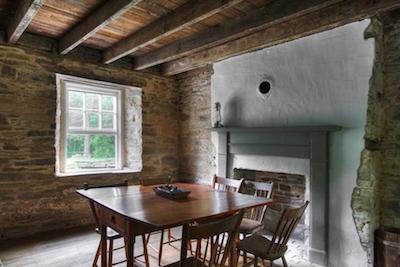
Ever consider spending a cold winter's night in one of the historic lockhouses inside the Chesapeake & Ohio Canal National Historical Park?/C&O Canal Trust
35. Spend a weekend, or a week, touring the Natchez Trace Parkway, which stretches from Tennessee to the Mississippi.
36. Turn the calendar back a century or so with an overnight stay at one of the lockhouses within the Chesapeake & Ohio Canal National Historical Park. The “Canal Quarters” program operated by the C&O Canal Trust makes six historic lockhouses available for overnight stays. Accommodations range from truly rustic—no heat, electricity, or running water—to full amenities, such as a modern stove, refrigerator and stove, as well as bathroom with shower. Rates run $100-$150 per night.



Add comment